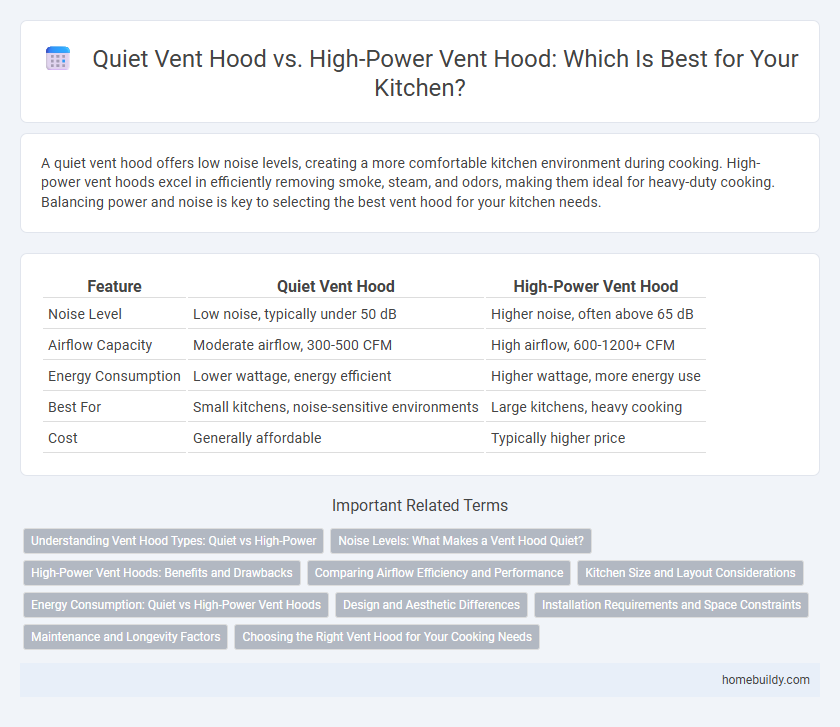A quiet vent hood offers low noise levels, creating a more comfortable kitchen environment during cooking. High-power vent hoods excel in efficiently removing smoke, steam, and odors, making them ideal for heavy-duty cooking. Balancing power and noise is key to selecting the best vent hood for your kitchen needs.
Table of Comparison
| Feature | Quiet Vent Hood | High-Power Vent Hood |
|---|---|---|
| Noise Level | Low noise, typically under 50 dB | Higher noise, often above 65 dB |
| Airflow Capacity | Moderate airflow, 300-500 CFM | High airflow, 600-1200+ CFM |
| Energy Consumption | Lower wattage, energy efficient | Higher wattage, more energy use |
| Best For | Small kitchens, noise-sensitive environments | Large kitchens, heavy cooking |
| Cost | Generally affordable | Typically higher price |
Understanding Vent Hood Types: Quiet vs High-Power
Quiet vent hoods prioritize noise reduction, typically operating below 50 decibels, making them ideal for open-concept kitchens and those sensitive to sound. High-power vent hoods focus on maximum airflow, often exceeding 600 cubic feet per minute (CFM), essential for heavy cooking and removing strong odors or smoke efficiently. Selecting between these types depends on kitchen size, cooking habits, and the balance between noise level and ventilation effectiveness.
Noise Levels: What Makes a Vent Hood Quiet?
Quiet vent hoods feature advanced insulation materials and precision-engineered motors that minimize noise by reducing vibrations and airflow turbulence. High-power vent hoods typically generate higher decibel levels due to their increased airflow capacity, which can create more noise through fan speed and air resistance. Noise levels for quiet models often range between 40-50 decibels, whereas high-power hoods can exceed 70 decibels, impacting kitchen comfort.
High-Power Vent Hoods: Benefits and Drawbacks
High-power vent hoods offer superior airflow capacity, efficiently removing smoke, grease, and odors from kitchens, which is essential for heavy cooking environments. They typically operate at higher decibel levels, making them noisier compared to quieter vent hood models but ensuring powerful ventilation. The increased energy consumption and potential for louder operation are notable drawbacks despite their effectiveness in maintaining air quality and preventing buildup of contaminants.
Comparing Airflow Efficiency and Performance
Quiet vent hoods excel in maintaining lower noise levels while providing moderate airflow rates, typically ranging from 300 to 600 CFM, suitable for standard cooking tasks. High-power vent hoods deliver superior airflow efficiency with capacities often exceeding 800 CFM, effectively removing smoke, grease, and odors from heavy cooking environments. Choosing between the two depends on balancing performance needs against noise tolerance and kitchen size, as high-power models ensure robust ventilation but generate increased sound levels.
Kitchen Size and Layout Considerations
Choosing between a quiet vent hood and a high-power vent hood depends heavily on kitchen size and layout; smaller kitchens benefit from quiet vent hoods that minimize noise without compromising air quality. Larger or open-concept kitchens require high-power vent hoods to effectively remove smoke, odors, and grease over a wider area. Proper vent hood sizing and placement ensure optimal ventilation performance tailored to the specific kitchen dimensions and cooking habits.
Energy Consumption: Quiet vs High-Power Vent Hoods
Quiet vent hoods typically consume less energy due to lower fan speeds and efficient motor designs, making them ideal for energy-conscious households. High-power vent hoods draw more electricity to achieve stronger airflow and faster smoke removal, resulting in increased energy consumption. Choosing between these types depends on balancing noise levels with power needs and energy efficiency priorities.
Design and Aesthetic Differences
Quiet vent hoods feature streamlined designs with noise-dampening materials, prioritizing subtlety and minimal visual impact for modern kitchens. High-power vent hoods often showcase larger, more industrial forms with exposed vents and robust metal finishes, emphasizing functionality and a bold aesthetic. The design choice directly influences kitchen ambiance, balancing between unobtrusive elegance and powerful visual presence.
Installation Requirements and Space Constraints
Quiet vent hoods typically require more specialized installation to ensure noise reduction, often involving additional soundproofing materials and precise placement that can limit flexibility in smaller kitchens. High-power vent hoods demand robust ductwork and larger clearances to accommodate stronger airflow and increased motor size, which can be challenging to install in compact or space-constrained environments. Considering ventilation capacity and kitchen layout is critical to balance noise levels and space efficiency during installation.
Maintenance and Longevity Factors
Quiet vent hoods typically feature lower airflow speeds and simpler motor designs, resulting in less wear and reduced maintenance needs over time. High-power vent hoods, with their robust motors and higher CFM ratings, demand more frequent filter cleaning and occasional motor servicing to ensure optimal performance and longevity. Choosing a vent hood involves balancing noise levels with maintenance commitment and the expected lifespan of components under regular use.
Choosing the Right Vent Hood for Your Cooking Needs
Choosing the right vent hood depends on balancing noise levels and extraction power to suit your cooking habits. Quiet vent hoods typically operate below 60 decibels, ideal for low to moderate cooking tasks, while high-power vent hoods provide stronger airflow, measured in cubic feet per minute (CFM), essential for heavy-duty frying or grilling. Selecting a model with the appropriate CFM and sound rating ensures efficient smoke removal without overwhelming kitchen noise.
Quiet vent hood vs High-power vent hood Infographic

 homebuildy.com
homebuildy.com